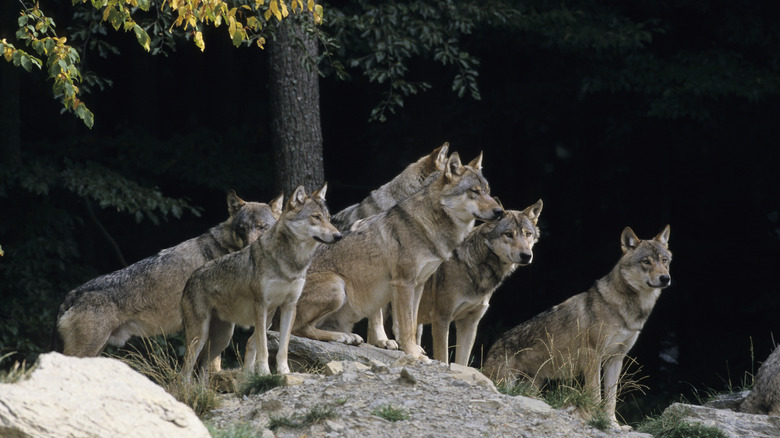Endangered Wolves Are Back In California, So Here's The Best Thing To Do If You See One
Rumors of wolf sightings have been spreading all over California. After four wolves were reported to be seen near Lake Tahoe, it could mean that the gray wolf — considered an endangered species — is more active than expected. It's not the first time gray wolves have been sighted, as this species returned to California in 2011 with seven packs confirmed in the Golden State. However, reports of fresh sightings will be music to the ears of wildlife lovers.
But wait, wolves are dangerous, right? While an increase in numbers could cause some panic across the community, wolves tend to avoid people and run away when encountering humans. Gray wolves are not considered dangerous to people, usually preferring not to interfere with humans unless a disruption in the ecosystem occurs or they feel threatened. Gray wolves are a vital part of the ecosystem as they help control herbivore populations such as deer, elk, rodents, and rabbits, creating a balance in vegetation growth and diversity.
If you do happen to see a gray wolf, the most important thing to do is to ensure the wolf has a clear path to escape. You should try to stay calm and avoid any alarming behavior that could trigger a defense mechanism from wolves, such as shouting or running. To find out how to respect these endangered species and avoid any possible harm, certain precautions should be taken into consideration.
What to do if you encounter a wolf
Encountering a wolf can sound pretty scary, and you can be forgiven for assuming that running as fast as you can would be the best way to protect yourself. However, trying to stay calm and avoiding any fast movements or behaviors that could be interpreted as a threat is recommended. It is best to stand tall, raising your arms over your head to appear larger, and slowly but calmly take a few steps back without turning your back to the wolf or running away. Maintaining eye contact is key, as you can monitor any changes in the wolf's behavior and take the necessary actions if it seems the wolf is in hunt mode. If the wolf does not retreat and continues to howl, a person should consider throwing objects to intimidate the animal, making it seem like you're too dangerous to attack.
Of course, the best way to avoid a dangerous interaction with a wolf in the wild is to, you know, not meet a wolf in the wild. Before heading out into areas with wolves, read up on breeding or denning seasons and stay away during this time as wolves tend to be more aggressive then. Other tips include leaving no food, garbage, or scented items that could attract wolves. Before camping or hiking in a specific area, it is always best to check if there has been a wolf sighting nearby.
Why is it dangerous to encounter wolves?
Despite being closely related, wolves are a world away from our furry friends back home. While wolf attacks are rare and fatalities even rarer, feeding wolves or leaving behind food or garbage that attracts them could remove the animal's fear of approaching people, leading to more potential risks. Most aggressive behavior is usually a result of wolves feeling threatened and needing to protect their territory or young pups during breeding season.
One other important factor to keep in mind is that just like many other wild animals, wolves are also susceptible to diseases. Being in close contact with humans could lead to the transmission of diseases such as rabies. While the risks are generally low (you are more likely to be attacked, injured, or even killed by dogs than wolves), it is still better to be safe than sorry when close to wolf territory. The gray wolf is a majestic animal and its return to California is cause for celebration, but safety must be every adventurer's priority.


